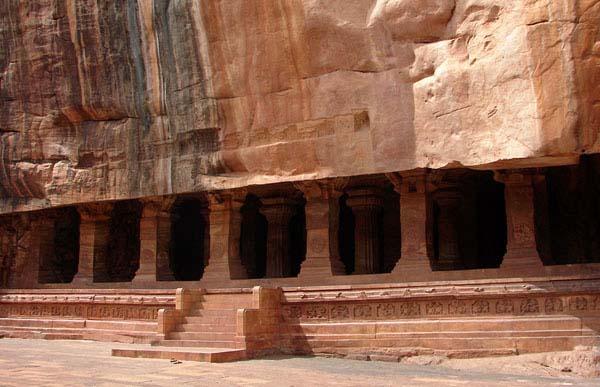Badami Cave Temples

Information of Badami Cave Temples, Bagalkot, Karnataka
Badami Cave Temples are the magnificent rock cut monument in India. This temple is listed in the UNSECO world heritage site in Karnataka, certified in the year 1987. This temple is looking like a heavenly abode of Hindu gods and goddesses in these caves. This rock cut temple is a finest example of fusion architecture carved by the Chalukayans, in the 6th to 8th century AD. The great king Pulikesi I and his son was the main persons behind this cave temples. The Badmi itself is a land of temples and it is considered as holy place by the Hindus. This cave temple and few other monuments are under the protected monument acts and there are no worships and rituals conducted here. It is now a ticketed monument and visitors can admire these deities and pray self without any offering like flowers and other related worship material in side this temple complexes. It is beautifully located at Badami Town, Bagalkot District of Karnataka State in India.
Badami Cave Temples Religious Significance
From 9th century AD to the medieval times, these temples were a divine place of worship for the Hindus and Jains. A large tank named Agasthiya Thirtha is nearby this temple and it is considered to be a holy tank. Pilgrims used to drink and take bath in this tank, which is well known for its elixir values. Many peoples believe and have realized the curing effect of few skin and hereditary diseases.
Badami Cave Temples Festival Significance
There is no particular festivals conducted in this cave temple, but the nearby three temples conduct its annual festival and pilgrims coming to those festival also visit this cave temples. Since, it became a heritage site, it is less known for its festival significance but well known for its historical important that highlight the importance of this world famous Badami Caves.
Badami Cave Temples Mythology & History
The Chalukayan King Pulikesi I was a great follower of Hindu religion. The Badami was his capital and he built many remarkable temples in his time. But this cave temple was something extraordinary to highlight its craftsmanship. These temples gave shape to the Chalukayan architecture a new identification in the south India.
Badami Cave Temples Architectural Significance
Badami Cave Temples are carved on huge monolith sand stones formed in the ravine areas of Badami in elevated hill areas. It is located near by the great tank called Agasthiys Thirrtha. This temple is found in a mix of the Nagara and Dravidian pattern. This fusion stone art makes this cave temple a unique on among the cave temples found in India. A huge monolith rock is carved in to cave forms by carving and cutting manually by thousand of skilled artisans brought from different parts of India. They just penetrated these rocks by carving pillars vacant spaces and making stone art of Hindu mythology in the entire man made cave complexes. There are four such caves built here. These are marked with serial number ranging from 1-4 by the archeological survey of India. Caves 1, 2 and 3 are built for Hindu temples and the cave No.4 is built for a Jain temple for Jainism followers. The Cave No.1, abodes the Lord Shiva and its sub deities. The Cave No.2 is dedicated to Lord Maha Vishnu and his sub deities. The Cave no.3 has many Hindu mythological sculptors or the Vedic relics in stone forms. The Cave No.4 is a Jain temple built for Lord Mahavira and his Thirthankaras are seen here. Inside these caves there are many pillars with bracket frieze. The walls are also filled with many beautiful friezes. The main deities are placed in Sanctum sanctorum, which are filled with Hindu designs. It has many wall reliefs too. All together one can find the entire Hindu mythological god and goddess in stone art forms. These are life-sized sculptors carved very artistically to see. There are many Hindu designs supporting these stone art and adds more beauty to these sculptors. Its callings are finely carved with beautiful motifs. The credit of this cave temple goes to those craftsmen's who manually built these caves to look like heavens.
- Andhra Pradesh Temples
- Assam Temples
- Bihar Temples
- New Delhi Temples
- Goa Temples
- Gujarat Temples
- Jammu and Kashmir Temples
- Karnataka Temples
- Kerala Temples
- Madhya Pradesh Temples
- Maharashtra Temples
- Odisha Temples
- Punjab Temples
- Rajasthan Temples
- Sikkim Temples
- Tamil Nadu Temples
- Telangana Temples
- Uttar Pradesh Temples
- Uttarakhand Temples
- West Bengal Temples